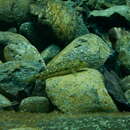pms
nòm ant ël fil


Awaous guamensis és una espècie de peix de la família dels gòbids i de l'ordre dels perciformes.
Els mascles poden assolir els 24,5 cm de longitud total.[3][4]
Es troba des de les Illes Mariannes i les Hawaii fins a Vanuatu, Nova Caledònia i Fidji.[3]
Awaous guamensis is a species of goby native to the Pacific islands from the Marianas to Vanuatu, New Caledonia and Fiji where it can be found in fresh, brackish and marine waters. Recent work based upon morphological and genetic differences has recognized Hawaiian populations of Awaous as being distinct from Awaous guamensis.[2] Consequently, Hawaiian Awaous are now recognized as a distinct species Awaous stamineus.[3][4]
Males can reach a length of 24.5 cm (9.6 in) SL while females only reach 16.5 cm (6.5 in).[5] The body has white streaks with speckles and a dark olive color.[6]
The species is found in slow-moving waters especially on Kaua‘i during their annual spawning run to the stream mouth.[7] ‘O‘opu nakea can swim upstream between 10 and 200 feet in strong currents.[8] They are omnivores, and their diet in one study was found to consist of 84% filamentous algae and 16% of chironomids (non-biting midges) and other animal food.[7]
Eggs are laid downstream where the males and females guard the nest. The males make the nest and attract the females who then lay one clutch per year.[9]
‘O‘opu nakea are eaten cooked; a common way of preparation is by salting them for 12 hours, then wrapping them in ti leaves and placing them on hot coals.[6]
{{cite book}}: CS1 maint: multiple names: authors list (link) Awaous guamensis is a species of goby native to the Pacific islands from the Marianas to Vanuatu, New Caledonia and Fiji where it can be found in fresh, brackish and marine waters. Recent work based upon morphological and genetic differences has recognized Hawaiian populations of Awaous as being distinct from Awaous guamensis. Consequently, Hawaiian Awaous are now recognized as a distinct species Awaous stamineus.
Awaous guamensis es una especie de peces de la familia de los Gobiidae en el orden de los Perciformes.
Los machos pueden llegar alcanzar los 24,5 cm de longitud total.[1]
Come algas, gusanos, crustáceos y larvas de insectos.
Es un pez de clima tropical y demersal.
Se encuentra desde las Islas Marianas y Hawái hasta Vanuatu, Nueva Caledonia y Fiyi.
Es inofensivo para los humanos.
Awaous guamensis es una especie de peces de la familia de los Gobiidae en el orden de los Perciformes.
Awaous guamensis Awaous generoko animalia da. Arrainen barruko Actinopterygii klasean sailkatzen da, Gobiidae familian.
Awaous guamensis Awaous generoko animalia da. Arrainen barruko Actinopterygii klasean sailkatzen da, Gobiidae familian.
Awaous guamensis est une espèce de gobies originaire des îles du Pacifique, des Mariannes au Vanuatu, en Nouvelle-Calédonie et aux Fidji, où on la trouve dans les eaux douces, saumâtres et marines.
Les mâles peuvent atteindre une longueur de 24,5 cm alors que les femelles n'atteignent que 16,5 cm[4].
Des travaux récents basés sur des différences morphologiques et génétiques ont reconnu les populations hawaïennes d’Awaous comme étant distinctes d’Awaous guamensis. Par conséquent, les populations d’Awaous hawaïens sont maintenant reconnus comme une espèce distincte Awaous stamineus[5].
Awaous guamensis est une espèce de gobies originaire des îles du Pacifique, des Mariannes au Vanuatu, en Nouvelle-Calédonie et aux Fidji, où on la trouve dans les eaux douces, saumâtres et marines.
Les mâles peuvent atteindre une longueur de 24,5 cm alors que les femelles n'atteignent que 16,5 cm.
Des travaux récents basés sur des différences morphologiques et génétiques ont reconnu les populations hawaïennes d’Awaous comme étant distinctes d’Awaous guamensis. Par conséquent, les populations d’Awaous hawaïens sont maintenant reconnus comme une espèce distincte Awaous stamineus.
Awaous guamensis is een straalvinnige vissensoort uit de familie van grondels (Gobiidae).[1] De wetenschappelijke naam van de soort is voor het eerst geldig gepubliceerd in 1837 door Valenciennes.
Bronnen, noten en/of referenties